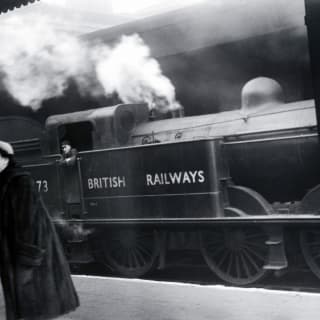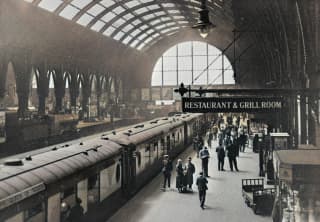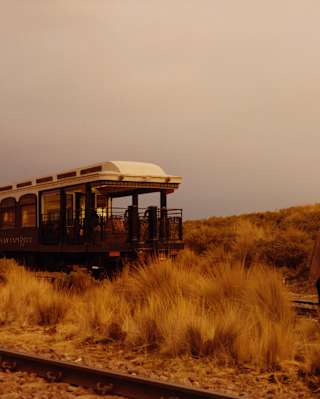Just the Ticket
Just the Ticket

Ever since a young Cornish engineer pioneered the first-ever train journey in South Wales in 1804, the world has been enamoured with the possibilities of the rail travel. Journalist, trains aficionado and author of 'Around the World in 80 Trains', Monisha Rajesh, leads us full steam ahead through Britain’s railway history – and explores how a new luxury train signals that slow travel is back on track.
Waking to the sound of a knock on your carriage door from your butler bringing you your morning pot of tea, you nudge up the blind to find a view of the sun warming mist-covered fields in motion. In a nest of crumpled damask sheets, you sip your tea with the china clinking on a tray, watch peachy-hued sunrise light fall on polished marquetry and listen to the sound of the train rattling along the rails. Wherever you are in the world, you’re cosy in your suite, going nowhere – and everywhere – with British pioneers to thank. While train travel didn’t begin with this level of indulgence, it didn’t take long for the first railways in Britian to expand from transporting freight such as limestone, iron and coal, to carrying chipper crowds of tourists to the beautiful British coastline.

On the 21st of February 1804, the world’s first train journey spanned ten miles of tramway from the ironworks at Penydarren to the Merthyr-Cardiff Canal in South Wales. Built by Cornish engineer, Richard Trevithick, the self-propelling steam locomotive pulled ten tons of iron – and seventy passengers. Even though the Northumberland-born George Stephenson was deemed the Father of the Railways for running the first passenger train on a public railway between Stockton and Darlington in 1825, his inventions were only possible as a result of Welsh innovations in the early nineteenth century. A global sensation, the Stockton and Darlington line was the first to use steam trains to transport passengers, but as little as five years later the Liverpool and Manchester freight line was launched alongside its passenger service. It was so successful that soon, railway fever rippled around the country; residents in every nook and cranny, from hamlets in Yorkshire to seaside towns in Cornwall, were desperate to be connected.
Railways rapidly changed the face of British tourism, with different classes and fares offering both the rich and the poor access to the salinity of the seaside air on day trips to Brighton, Southampton and Portsmouth – day trips only, as luggage wasn’t initially allowed on board. Trains were rough and ready in the 19th century, lacking toilets, heating and lighting. Their purpose was to take passengers from one point to the next, but the effect on society was extraordinary: it resulted in the standardisation in British time, the breakdown of class and social barriers, and more than anything it ignited a fire in Britons to explore their country as far as the tracks would take them.

A first-class luxury dining car on Britain’s Great Eastern Railway, 1912.
Over two hundred years later, after the pandemic in 2020, travellers were forced to slow down, take stock and reassess the way they move around the world and train travel re-emerged once more as a way to travel more sustainably and thoughtfully. Leaving a minimal carbon footprint, trains offer a special sort of intimacy, getting into the centres of towns and cities, pulling passengers past the backs of people’s houses, gardens hung with laundry and strewn with children’s toys. They light up darkened forests, reveal the dawn skies and carve up the countryside where no car or bus could ever go. Journeys like these indulge in a secret form of slowness to which train travel holds the key.
The United Kingdom already has several luxury trains to offer, thanks to Belmond’s Royal Scotsman – where passengers can taste fresh scallops caught around the Kyle of Lochalsh, and sip the hot sting of whisky while stabled in the town of Keith – and British Pullman, where day trips to manors and castles take place on impeccably restored carriages from the 1920s.


From July 2025, the Britannic Explorer, A Belmond Train, will continue the grand tradition of British journeying with much to do both on board and off. From a choice of three unique overnight journeys and itineraries around England and Wales, passengers can wind down to Somerset and the Cornish coast, belt around the Lake District, and curve into the Cotswolds and Wales. Each adventure will pull passengers into the most glorious folds of Britain’s landscapes, with opportunities to hike estates, cycle through farmlands and marvel at private collections of art.
On board, the Britannic Explorer will showcase all the quirks and eccentricities of Britain with a bar inspired by Victorian apothecaries, indulgent interiors and a dining service curated by restaurateur Simon Rogan. Best of all, there will be an observation car where passengers can gather together, nightcap in hand, and gaze out at the silvery mist of stars as the train sweeps on through the night, in homage to pioneers of the past.
Delve deeper into
You might also enjoy

Andean Explorer, As Seen By Colin Dodgson
In the latest instalment of Belmond’s ‘As Seen By’ photography series, Colin Dodgson embarks on a Peruvian odyssey through natural wonders aboard the Andean Explorer train.

Privacy in Motion
Travelling in luxury by train or boat recalls a sense of cinematic glamour. Now, takeovers and charters are the new way to recreate a rollicking spirit of celebration for special occasions.

Belmond Legends: Mount Nelson
The one trailblazer of Cape Town and the icon behind the ‘Mount Nelson Pink’ carnation, our mythical hotel has set the standard for luxury for more than a century – discover the Belmond legend.

Belmond’s Best Beach Villas
“I shall wear white flannel trousers and walk upon the beach,” T.S. Eliot wrote in a wistful ode to life by the sea. Surely the best way to appreciate it is from the comfort of your own villa – ideally with a cocktail in hand.

Where to Set-Jet in 2025
More than ever, travellers are picking travel spots featured on their favourite TV shows and films. We investigate the trend and look ahead to the stop set-jetting spots for 2025, from deep valleys of Caledonia to the plains of Peru.

Why Summer Is the Best Time to Visit Lima
In the summer, the mysterious sea mist lifts and limeños come alive. Lima, the foodie capital of South America, is vibrant and cosmopolitan year-round – but her best side is seen between December and April. Fresh from a whirlwind nationwide tour celebrating Belmond’s 25 years in Peru, writer Alexandra Pereira shares her Lima highlights.

Insider’s Guide to Anguilla
With palm-fringed beaches, luxurious hotels and an impressive array of restaurants, the Caribbean island of Anguilla is a sun-seekers dream realised. Travel writer and ‘Carivangelist’ Sarah Graves-Gabbadon gives you the low-down on the perfect high-end getaway.